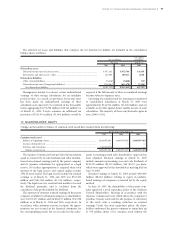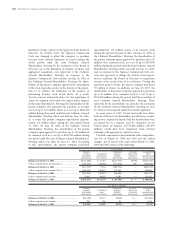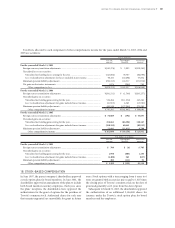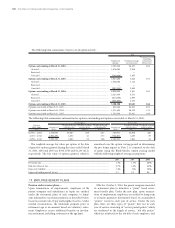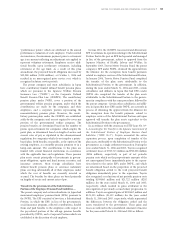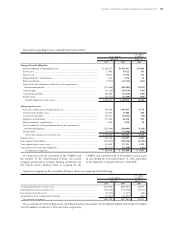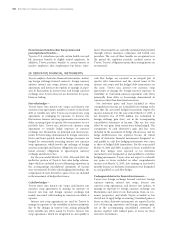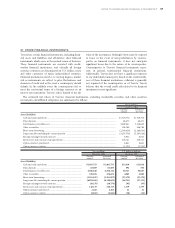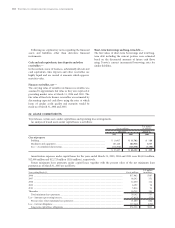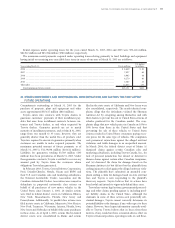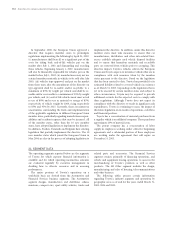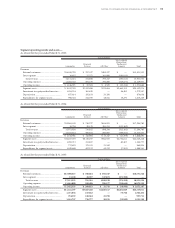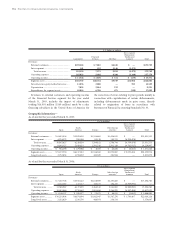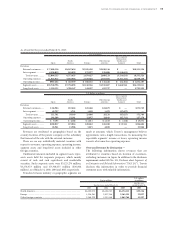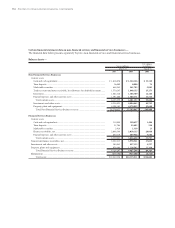Toyota 2005 Annual Report Download - page 110
Download and view the complete annual report
Please find page 110 of the 2005 Toyota annual report below. You can navigate through the pages in the report by either clicking on the pages listed below, or by using the keyword search tool below to find specific information within the annual report.
108 >NOTES TO CONSOLIDATED FINANCIAL STATEMENTS
Postretirement benefits other than pensions and
postemployment benefits—
Toyota’s U.S. subsidiaries provide certain health care and
life insurance benefits to eligible retired employees. In
addition, Toyota provides benefits to certain former or
inactive employees after employment, but before retire-
ment. These benefits are currently unfunded and provided
through various insurance companies and health care
providers. The costs of these benefits are recognized over
the period the employee provides credited service to
Toyota. Toyota’s obligations under these arrangements are
not material.
20. DERIVATIVE FINANCIAL INSTRUMENTS
Toyota employs derivative financial instruments, includ-
ing foreign exchange forward contracts, foreign currency
options, interest rate swaps, interest rate currency swap
agreements and interest rate options to manage its expo-
sure to fluctuations in interest rates and foreign currency
exchange rates. Toyota does not use derivatives for specu-
lation or trading.
Fair value hedges—
Toyota enters into interest rate swaps, and interest rate
currency swap agreements mainly to convert its fixed-rate
debt to variable-rate debt. Toyota uses interest rate swap
agreements in managing its exposure to interest rate
fluctuations. Interest rate swap agreements are executed as
either an integral part of specific debt transactions or on a
portfolio basis. Toyota uses interest rate currency swap
agreements to entirely hedge exposure to currency
exchange rate fluctuations on principal and interest pay-
ments for borrowings denominated in foreign currencies.
Notes and loans payable issued in foreign currencies are
hedged by concurrently executing interest rate currency
swap agreements, which involve the exchange of foreign
currency principal and interest obligations for each func-
tional currency obligations at agreed-upon currency
exchange and interest rates.
For the years ended March 31, 2003, 2004 and 2005, the
ineffective portion of Toyota’s fair value hedge relation-
ships which are included in cost of financing operations in
the accompanying consolidated statements of income
were not material. For fair value hedging relationships, the
components of each derivative’s gain or loss are included
in the assessment of hedge effectiveness.
Cash flow hedges—
Toyota enters into interest rate swaps, and interest rate
currency swap agreements to manage its exposure to
interest rate risk, and foreign currency exchange risk
mainly associated with funding in currencies in which it
operates.
Interest rate swap agreements are used by Toyota to
manage its exposure to the variability of interest payments
due to the changes in interest rates arising principally
from variable-rate debts issued by Toyota. Interest rate
swap agreements, which are designated as, and qualify as
cash flow hedges are executed as an integral part of
specific debt transactions and the critical terms of the
interest rate swaps and the hedged debt transactions are
the same. Toyota uses interest rate currency swap
agreements to manage the foreign-currency exposure to
variability in functional-currency-equivalent cash flows
principally from debts or borrowings denominated in
currencies other than functional currencies.
Net derivative gains and losses included in other
comprehensive income are reclassified into earnings at the
time that the associated hedged transactions impact the
income statement. For the year ended March 31, 2003, a
net derivative loss of ¥790 million was reclassified to
foreign exchange gain (loss), net in the accompanying
consolidated statements of income. This net loss were
offset by net gains from transactions being hedged. The
components of each derivative’s gain and loss were
included in the assessment of hedge effectiveness, and no
hedge ineffectiveness was reported because all critical
terms of derivative financial instruments designated as,
and qualify as, cash flow hedging instruments were same
as those of hedged debt transactions. For the years ended
March 31, 2004 and 2005, no gains or losses resulted from
cash flow hedges were reported as no derivative
instruments were designated as, and qualified as cash flow
hedging instruments. Toyota does not expect to reclassify
any gains or losses included in other comprehensive
income as at March 31, 2005, into earnings in next twelve
months because no derivative instruments were designated
as, and qualified as, cash flow hedges.
Undesignated derivative financial instruments—
Toyota uses foreign exchange forward contracts, foreign
currency options, interest rate swaps, interest rate
currency swap agreements, and interest rate options, to
manage its exposure to foreign currency exchange rate
fluctuations and interest rate fluctuations from an eco-
nomic perspective, and which Toyota is unable or has
elected not to apply hedge accounting. Unrealized gains or
losses on these derivative instruments are reported in the
cost of financing operations and foreign exchange gain,
net in the accompanying consolidated statements of
income together with realized gains or losses on those
derivative instruments.



